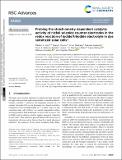Probing the stoichiometry dependent catalytic activity of nickel selenide counter electrodes in the redox reaction of iodide/triiodide electrolyte in dye sensitized solar cells

View/
Publication Date
2020Author
Mildred A Airo, Francis Otieno, Lineo Mxakaza, Adewale Ipadeola, Rudo S Kadzutu-Sithole, Lerato FE Machogo-Phao, Caren Billing, Makwena Moloto, Nosipho Moloto
Metadata
Show full item recordAbstract/
Nickel selenide (NixSey) systems have received much attention in recent years as potential low cost counter
electrodes (CEs) in dye sensitized solar cells (DSSCs). Their electrocatalytic activities are comparable to that
of the conventional platinum CE. Despite their achievements, the effect of stoichiometry on their catalytic
performance as CEs in DSSCs still remains unclear, hence the motivation for this work. Different
stoichiometries of NixSey were synthesized via a colloidal method in oleylamine or oleylamine/oleic acid
mixture at the appropriate synthetic temperature and Ni to Se precursor ratio. X-ray diffraction revealed
that different stoichiometries of nickel selenide were formed namely, NiSe2, Ni3Se4, Ni0.85Se, NiSe and
Ni3Se2. Scanning electron microscopy showed that all the stoichiometries had predominantly sphericallike morphologies. Cyclic voltammetry, electrochemical impedance spectroscopy analysis and the
photovoltaic performances of the DSSCs fabricated using the different NixSey CEs revealed that selenium
rich stoichiometries performed better than the nickel rich ones. Consequently, the catalytic activity
towards the redox reaction of the triiodide/iodide electrolyte and hence the power conversion efficiency
(PCE) followed the order of NiSe2 > Ni3Se4 > Ni0.85Se > NiSe > Ni3Se2 with PCE values of 3.31%, 3.25%,
3.17%, 2.35% and 1.52% respectively under ambient conditions
